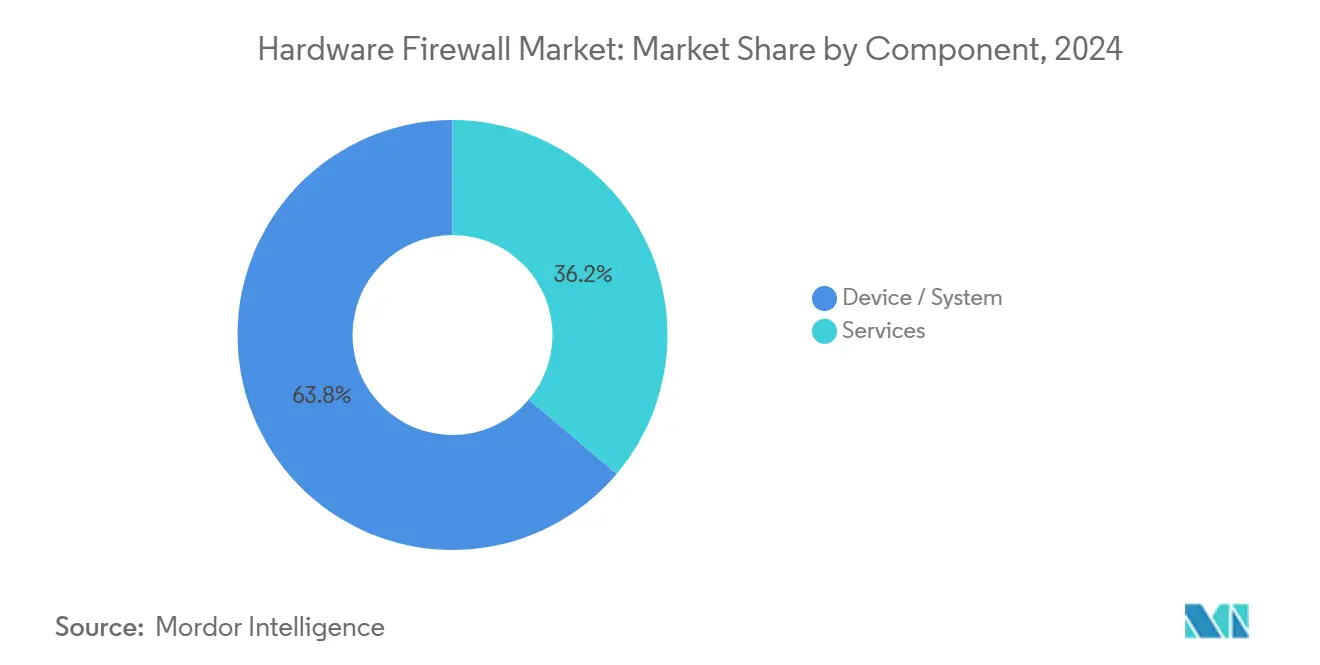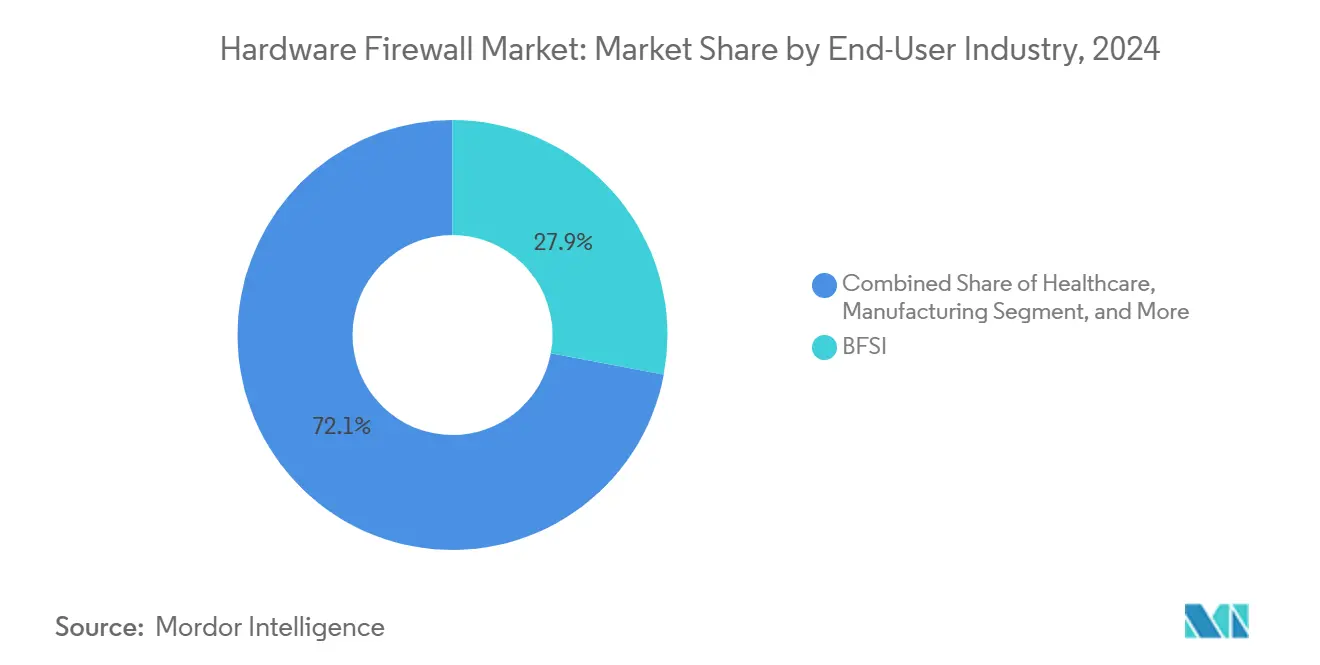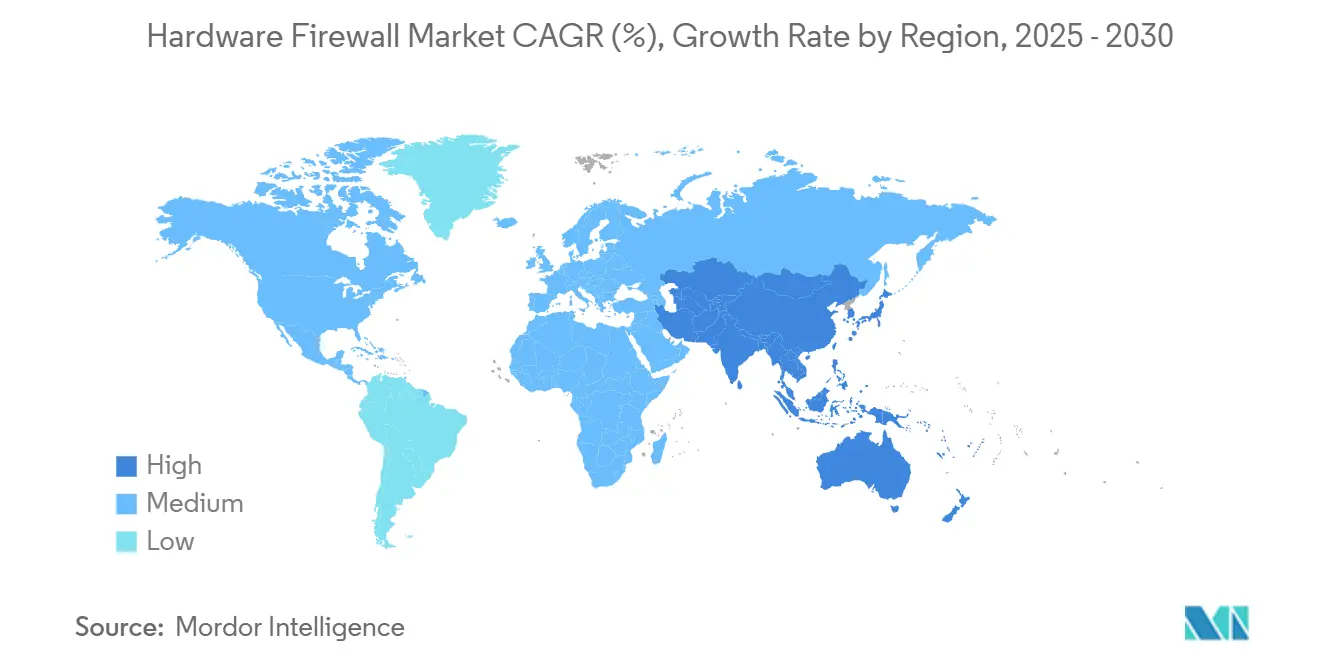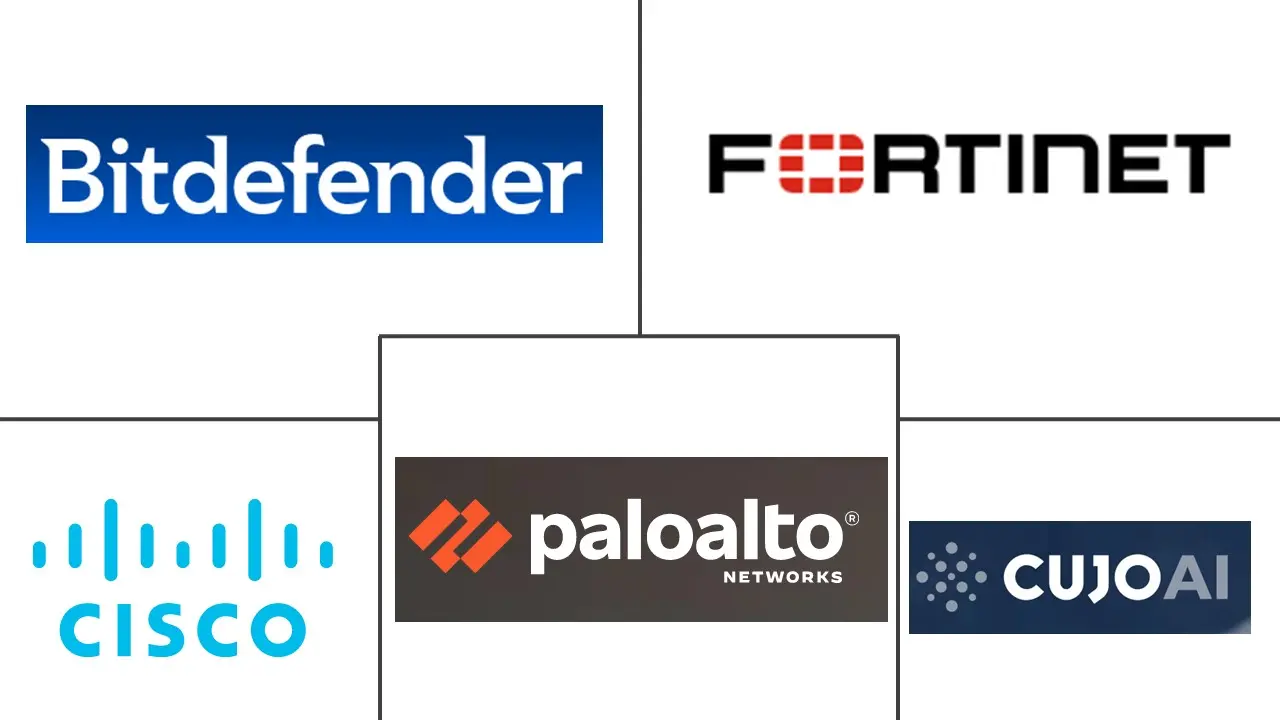Hardware Firewall Market Size and Share

Hardware Firewall Market Analysis by Mordor Intelligence
The hardware firewall market size stands at USD 22.87 billion in 2025 and is projected to reach USD 38.81 billion by 2030, translating into an 11.15% CAGR over the forecast period. Accelerated demand arises from zero-trust mandates in federal and critical-infrastructure networks, edge-computing adoption, 5G densification, and the growing volume of encrypted traffic that now exceeds 90% of total data flows. Device/System hardware continues to dominate revenues, yet managed services expand faster as enterprises substitute capital purchases with outcome-based contracts. Large enterprises drive refresh cycles for terabit-class appliances, while SMEs fuel incremental growth by adopting simplified unified-threat platforms. Regionally, North America retains the lead, but Asia-Pacific registers the quickest expansion as China, India, and ASEAN members align regulatory frameworks with global cybersecurity norms.
Key Report Takeaways
- By component, device/system led with 63.83% of the hardware firewall market share in 2024, while Services recorded the highest projected CAGR at 12.90% through 2030.
- By organization size, large enterprises accounted for 68.93% share of the hardware firewall market size in 2024, whereas SMEs are expanding at a 13.11% CAGR to 2030.
- By end-user industry, BFSI captured 27.94% revenue share in 2024 in the hardware firewall market and Healthcare is set to grow fastest at 11.78% CAGR to 2030.
- By firewall type, next-generation firewalls held 41.82% share of the hardware firewall market in 2024, while AI-accelerated firewalls advance at a 12.56% CAGR over the same period.
- By geography, North America commanded 38.73% share of the hardware firewall market size in 2024 and Asia-Pacific is projected to register a 12.66% CAGR through 2030.
Global Hardware Firewall Market Trends and Insights
Drivers Impact Analysis
| Driver | (~) % Impact on CAGR Forecast | Geographic Relevance | Impact Timeline |
|---|---|---|---|
| Increasing sophistication of multi-vector cyber-attacks necessitating ASIC-accelerated inspection | +2.1% | Global, with concentration in North America and EU | Medium term (2-4 years) |
| Government zero-trust mandates for federal and critical-infrastructure networks | +1.8% | North America and EU, expanding to APAC | Short term (≤ 2 years) |
| Edge-computing and 5G densification requiring distributed micro-firewall nodes | +2.2% | APAC core, spill-over to North America | Medium term (2-4 years) |
| Reshoring incentives and tariffs spurring domestic appliance production | +1.9% | North America, with secondary effects in EU | Long term (≥ 4 years) |
| SD-WAN replacement of MPLS driving hardware NGFW refresh cycles | +1.6% | Global, led by North America and EU enterprises | Short term (≤ 2 years) |
| Falling AI-coprocessor costs enabling mid-market terabit-class appliances | +0.9% | Global, with early adoption in developed markets | Medium term (2-4 years) |
| Source: Mordor Intelligence | |||
Increasing Sophistication of Multi-Vector Cyber-Attacks Necessitating ASIC-Accelerated Inspection
Threat actors now combine ransomware, supply-chain exploits, and state-sponsored operations, overwhelming CPU-centric inspection engines. CISA documented 1,132 known exploited vulnerabilities in 2024, a 23% rise over 2023.[1]CISA, “Zero Trust Maturity Model,” cisa.gov Dedicated ASICs embedded in hardware appliances process encrypted traffic at line rate, enabling real-time threat mitigation without introducing latency. Fortinet’s SP5 ASIC platform reaches 3.2 Tbps throughput with sub-microsecond inspection delays, exemplifying the leap in silicon-level security performance.[2]Fortinet, “SP5 ASIC Architecture,” fortinet.com Machine-learning inference integrated inside these chips supports behavioral detection of zero-day attacks that signature-based engines miss. NIST’s Cybersecurity Framework 2.0 explicitly references hardware-accelerated controls for critical-infrastructure protection.
Government Zero-Trust Mandates for Federal and Critical-Infrastructure Networks
Executive Order 14028 obliges U.S. federal agencies to adopt zero-trust architectures by fiscal 2024, backed by USD 9.8 billion in modernization funding.[3]White House, “National Cybersecurity Strategy,” whitehouse.gov The directive drives bulk procurement of high-throughput appliances capable of continuous verification, micro-segmentation, and encrypted-traffic analytics. Parallel mandates arise in defense contracting, where CMMC 2.0 requires hardware firewalls for Level 3 compliance across 220,000 suppliers. Europe’s NIS2 Directive imposes comparable safeguards on essential services, broadening demand across the Atlantic. Hardware appliances have shifted from optional perimeter guards to indispensable enforcement nodes within government-regulated networks.
Edge-Computing and 5G Densification Requiring Distributed Micro-Firewall Nodes
Private 5G deployments and the proliferation of edge servers redefine network perimeters. GSMA forecasts 18,600 private 5G sites worldwide by 2030, each requiring sub-10 millisecond security processing. Compact high-performance firewalls now ship in ruggedized form factors that can secure manufacturing lines, autonomous vehicles, and tactical military units. The U.S. DoD identifies edge security as a critical gap in its 5G-to-NextG program and prioritizes hardware deployment at forward-operating bases. Latency-sensitive applications, from augmented-reality maintenance to autonomous drones, rely on localized inspection that virtual appliances cannot match.
SD-WAN Replacement of MPLS Driving Hardware NGFW Refresh Cycles
Enterprises are pivoting from cost-intensive MPLS links to SD-WAN architectures that dynamically route traffic over multiple ISPs. Cisco reports that 76% of enterprises plan SD-WAN rollouts within two years, naming integrated security as the top criterion. Branch-level NGFWs with embedded routing, QoS, and threat prevention enable consistent policies even when traffic exits directly to the internet. Palo Alto Networks’ Prisma SD-WAN hardware consolidates networking and security capabilities, reducing total cost of ownership by up to 60% relative to discrete MPLS plus firewall stacks.
Restraints Impact Analysis
| Restraint | (~) % Impact on CAGR Forecast | Geographic Relevance | Impact Timeline |
|---|---|---|---|
| Rapid shift to Firewall-as-a-Service cannibalising on-prem hardware demand | -1.4% | Global, led by North America cloud adoption | Short term (≤ 2 years) |
| Supply-chain volatility for network-processing chips | -0.8% | Global, with acute impact on Asia-Pacific manufacturing | Medium term (2-4 years) |
| Privacy-driven limits on encrypted-traffic inspection | -0.6% | EU and privacy-conscious markets | Long term (≥ 4 years) |
| Rising energy costs of high-throughput appliances | -0.7% | Europe and regions with high energy costs | Medium term (2-4 years) |
| Source: Mordor Intelligence | |||
Rapid Shift to Firewall-as-a-Service Cannibalizing On-Premises Hardware Demand
Cloud-delivered security models erode demand for on-premise boxes among organizations seeking frictionless scalability. Zscaler’s 2024 results showed 35% annual revenue growth, underscoring appetite for service-based offerings that eliminate hardware ownership. Mid-market firms with lean IT staff gravitate toward managed firewalls, although performance and data-sovereignty requirements still anchor many enterprises to on-prem hardware. The hardware firewall market therefore faces a bifurcated future where service models absorb low-to-mid range demand while high-performance needs remain appliance-centric.
Supply-Chain Volatility for Network-Processing Chips
Advanced network processors are mostly manufactured in Taiwan and South Korea, exposing vendors to geopolitical and logistical shocks. Lead times for Broadcom chips stretched to 18 months in 2024, prompting product redesigns and inflated costs. The U.S. CHIPS Act allocates USD 52 billion to local fabrication but will not deliver meaningful capacity until after 2027. Vendors that design flexible architectures or dual-source key components gain resilience, but smaller firms face margin pressure and delayed launches.
Segment Analysis
By Component: Device/System Dominance with Services Momentum
Device/System hardware commanded 63.83% of the hardware firewall market in 2024 as enterprises prioritized ASIC-based throughput for encrypted-traffic inspection. Services, however, race ahead at a 12.90% CAGR as organizations outsource configuration, monitoring, and incident response to vendor-run centers. The hardware firewall market size for Services is on track to double by 2030 as outcome-based contracts displace capital expenditures. Large enterprises continue to refresh chassis-based boxes, but SMEs increasingly prefer vendor-hosted management that sidesteps staffing shortages.
Enterprises embracing zero-trust architectures deploy hardware appliances as enforcement nodes, then overlay managed detection and response subscriptions. Fortinet grew support-services revenue 23% year over year, signaling steady managed-services uptake. Integration complexity around AI-accelerated appliances further elevates demand for professional services. As 5G micro-sites proliferate, installation and lifecycle contracts will remain critical revenue anchors for service providers.

By Organization Size: SME Acceleration Challenges Enterprise Dominance
Large enterprises held 68.93% of the hardware firewall market share in 2024, reflecting global refresh cycles among banks, telcos, and hyperscale cloud providers. SMEs, though smaller in absolute spend, post a 13.11% CAGR that narrows the gap each year. The hardware firewall market size attributable to SMEs benefits from cloud-managed consoles that reduce administrative overhead and from vendor financing that converts upfront costs into subscription outlays.
Government grants and cyber-insurance mandates further pull SMEs into compliance regimes. The U.K. Cyber Security Breaches Survey 2024 found that 75% of SMEs now deploy at least one firewall, demonstrating penetration beyond early adopters. Vendors bundle simplified policy templates and automated updates to meet limited in-house expertise, while channel partners package firewalls with broadband circuits for turnkey protection.
By End-User Industry: Healthcare Momentum Challenges BFSI Leadership
BFSI retained 27.94% of 2024 revenue on the back of stringent transaction-security mandates and high-value data stores. Healthcare, propelled by telehealth and HIPAA compliance, grows fastest at 11.78% CAGR to 2030. The hardware firewall market size within healthcare reflects rapid digitization of patient records and remote monitoring devices that demand strict segmentation. Manufacturing adopts hardware firewalls to protect converged IT-OT networks, aligning with NIST’s manufacturing cybersecurity profile.
Pharma labs deploying Internet-connected sensors require terabit-class appliances for genome data transfers. Retail builds perimeter defenses to satisfy PCI DSS audits, while government agencies refresh fleets under zero-trust deadlines. Each vertical’s regulatory fabric dictates appliance capabilities, driving tailored offerings such as redundant power supplies for hospitals and ruggedized chassis for plant floors.

Note: Segment shares of all individual segments available upon report purchase
By Firewall Type: AI-Accelerated Innovation Disrupts NGFW Dominance
Next-Generation Firewalls delivered 41.82% of hardware firewall market revenue in 2024 by integrating application identification, IPS, and URL filtering. AI-Accelerated models outpace all others at 12.56% CAGR as silicon-embedded machine learning identifies anomalous packet flows in real time. The hardware firewall market share for AI-Accelerated units is poised to double by 2030 as enterprises seek automated detection of zero-day malware.
Packet-Filtering units persist in hyperscale data centers where raw throughput overshadows inspection depth. Unified-Threat appliances address resource-constrained environments by combining malware protection, VPN, and sandboxing into a single box. Fortinet’s 4400F sets the performance ceiling with 1.8 Tbps of threat-protected throughput, illustrating the direction of future flagship releases.
Geography Analysis
North America held 38.73% of hardware firewall market revenue in 2024, buoyed by USD 65 billion in federal cybersecurity spending and concentrated technology-sector demand. U.S. critical-infrastructure operators accelerate refresh cycles to align with CISA performance goals, while Canada expands public-sector investment through its Digital Charter. Mexican factories integrate firewalls into Industry 4.0 lines as the USMCA eases cross-border hardware flows.
Asia-Pacific records the fastest regional CAGR at 12.66% through 2030. China enforces its Data Security Law, obliging foreign and domestic firms to adopt certified network gear. India targets a USD 1 trillion digital economy by 2025, channeling incentives toward secure broadband and data-center build-outs. Japan’s Society 5.0 pushes 5G and edge-computing, necessitating micro-firewall deployments across connected factories and smart-city grids. South Korea’s K-Digital New Deal funds cyber-physical infrastructure that prefers on-premise protection over cloud.
Europe grows steadily on GDPR and NIS2 compliance requirements that emphasize data-sovereignty and hardware enforcement. Germany’s Industry 4.0 and France’s cloud-sovereignty programs propel enterprise spending on local inspection points. The U.K. National Cyber Strategy extends after Brexit, positioning domestic security vendors for government contracts. Middle East and Africa trails but accelerates as Saudi Arabia’s Vision 2030 and the UAE’s digital-nation roadmaps prioritize telecom-grade protection. African fintech adoption fuels purchases for mobile money platforms where packet loss equates to revenue loss.

Competitive Landscape
The top five suppliers command roughly 65% of the hardware firewall market, indicating moderate concentration. Fortinet leads with an estimated 19.8% share, leveraging its ASIC roadmap and single-pane management framework. Palo Alto Networks follows by combining NGFW strength with SIEM after acquiring IBM’s QRadar platform. Cisco applies its routing heritage to integrate SD-WAN and firewall functions, appealing to enterprises seeking unified stacks.
Emerging challengers emphasize AI-embedded packet analysis and specialized industrial-control defenses. Patent filings in machine learning-based inspection rose 340% between 2022 and 2024, signaling sustained R&D momentum. Vendors differentiating on encrypted-traffic visibility and zero-trust access gateways position for outsized growth. Service providers favor appliance families that extend into cloud form factors without rewriting policy controls, rewarding suppliers with converged management layers. As edge-computing nodes multiply, firewall SKUs optimized for low power and rugged environments gain traction among 5G operators and manufacturing integrators.
Channel ecosystems evolve alongside product strategy. Global distributors bundle financing, integration, and managed services to mitigate customer capex hesitation. Alliances between firewall makers and public-cloud providers unlock hybrid use cases that tether on-prem devices to cloud-native monitoring backplanes. Vendors unable to deliver seamless policy portability across data center, branch, and cloud risk losing share to platforms offering full-spectrum coverage.
Hardware Firewall Industry Leaders
-
Cisco Systems, Inc.
-
Cujo LLC
-
Fortinet Inc.
-
Palo Alto Networks Inc.
-
Bitdefender SRL
- *Disclaimer: Major Players sorted in no particular order

Recent Industry Developments
- January 2025: Fortinet announced a USD 2.1 billion investment in SP6 ASIC development for terabit-scale AI-accelerated threat detection.
- December 2024: Palo Alto Networks completed its USD 3.2 billion acquisition of IBM’s QRadar security intelligence platform.
- November 2024: Cisco launched Firepower 1200 appliances with integrated SD-WAN and AI-powered analytics.
- October 2024: Check Point partnered with Microsoft to integrate firewall functions into Azure hybrid deployments.
Global Hardware Firewall Market Report Scope
A firewall hardware, also known as a physical firewall device, is an appliance that fits between the client system and the uplink and filters traffic according to user profiles, security policies, and business rules that have been pre-configured. The uplink transmits traffic from private or public networks to the client system, which can be a server, a WFH system, an employee workstation, or an IoT node.
The hardware firewall market is segmented by component (device/system and services (installation services)), organization size (SMEs and large enterprises), end-user industry (healthcare, manufacturing, government, IT and telecom, and education), and geography (North America, Europe, Asia-Pacific (China, Japan, India, Malaysia, Thailand, Vietnam, Singapore, Philippines, Indonesia, Rest of Asia-Pacific), Middle East and Africa, and Latin America). The market sizes and forecasts are provided in terms of value (USD) for all the segments.
| Device / System |
| Services (Installation, Support, Managed) |
| Small and Medium-sized Enterprises (SMEs) |
| Large Enterprises |
| BFSI |
| Healthcare |
| Manufacturing |
| Government and Defense |
| IT and Telecom |
| Retail and E-commerce |
| Education |
| Packet-Filtering Firewalls |
| Circuit-Level Gateways |
| Application-Level / Proxy Firewalls |
| Unified Threat Management (UTM) |
| Next-Generation Firewalls (NGFW) |
| AI-Accelerated / Terabit-class Firewalls |
| North America | United States | |
| Canada | ||
| Mexico | ||
| South America | Brazil | |
| Argentina | ||
| Rest of South America | ||
| Europe | United Kingdom | |
| Germany | ||
| France | ||
| Italy | ||
| Spain | ||
| Netherlands | ||
| Rest of Europe | ||
| Asia-Pacific | China | |
| Japan | ||
| South Korea | ||
| India | ||
| ASEAN | ||
| Rest of Asia-Pacific | ||
| Middle East and Africa | Middle East | Saudi Arabia |
| United Arab Emirates | ||
| Turkey | ||
| Rest of Middle East | ||
| Africa | South Africa | |
| Nigeria | ||
| Kenya | ||
| Rest of Africa | ||
| By Component | Device / System | ||
| Services (Installation, Support, Managed) | |||
| By Organization Size | Small and Medium-sized Enterprises (SMEs) | ||
| Large Enterprises | |||
| By End-user Industry | BFSI | ||
| Healthcare | |||
| Manufacturing | |||
| Government and Defense | |||
| IT and Telecom | |||
| Retail and E-commerce | |||
| Education | |||
| By Firewall Type | Packet-Filtering Firewalls | ||
| Circuit-Level Gateways | |||
| Application-Level / Proxy Firewalls | |||
| Unified Threat Management (UTM) | |||
| Next-Generation Firewalls (NGFW) | |||
| AI-Accelerated / Terabit-class Firewalls | |||
| By Geography | North America | United States | |
| Canada | |||
| Mexico | |||
| South America | Brazil | ||
| Argentina | |||
| Rest of South America | |||
| Europe | United Kingdom | ||
| Germany | |||
| France | |||
| Italy | |||
| Spain | |||
| Netherlands | |||
| Rest of Europe | |||
| Asia-Pacific | China | ||
| Japan | |||
| South Korea | |||
| India | |||
| ASEAN | |||
| Rest of Asia-Pacific | |||
| Middle East and Africa | Middle East | Saudi Arabia | |
| United Arab Emirates | |||
| Turkey | |||
| Rest of Middle East | |||
| Africa | South Africa | ||
| Nigeria | |||
| Kenya | |||
| Rest of Africa | |||
Key Questions Answered in the Report
What is the projected value of the hardware firewall market in 2030?
The market is forecast to reach USD 38.81 billion by 2030 based on an 11.15% CAGR.
Which segment grows fastest within the hardware firewall market?
AI-Accelerated firewalls lead growth at a 12.56% CAGR through 2030 due to embedded machine-learning inspection.
Why are SMEs adopting hardware firewalls rapidly?
Cloud-managed consoles, subscription pricing, and compliance mandates drive a 13.11% CAGR in SME deployments.
Which region records the highest growth rate?
Asia-Pacific posts a 12.66% CAGR thanks to China’s Cybersecurity Law enforcement and India’s Digital India push.
How much market share does Fortinet hold?
Fortinet controls about 19.8% of global revenue, the highest among hardware firewall vendors.
Page last updated on:



